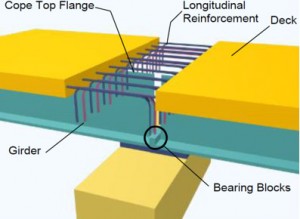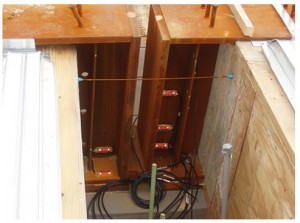Link to Latest Report: Final Report
Background:
Simple for Dead Load and Continuous for Live Load (SDCL) bridge system has no bolts or expansion joints resulting in higher service life and many other advantages. This system is also best suited for accelerating the construction process. It is ideal for building individual spans off site, transporting them to the final location and then joining the spans over the middle piers to create continuity for live load. The objective of this research project is to extend the application of the SDCL bridge system to highly seismic areas.
Recently a new steel bridge system, referred to as “Simple for Dead Load and Continuous for Live Load (SDCL)” has gained popularity in non-seismic areas of the country. In the SDCL bridge system there are no bolts or expansion joints in this system, resulting in higher service life, in addition to many other advantages. This system is also best suited for accelerating the construction process. It is ideal for building individual spans off site, transporting them to the final location and then joining the spans over the middle piers to create continuity for live load.
Previous research on the system has resulted in development of complete design and detailing provisions for this new system for non-seismic applications. However, to-date no research studies have been conducted to extend the applicability of this system to seismic regions, either for conventional or ABC. The main objective of this proposed concept as a research area is to use the available research data generated over the past 10 years and conduct combination experimental and numerical work to develop details and design provisions for extending the application of the SDCL bridge system to highly seismic areas. The focus of the study will be on using this system in conjunction with accelerated bridge construction philosophy. This should provide highly seismic areas with an excellent steel bridge alternative that does not have expansion joints and potentially produces long service life, while meeting seismic design requirements.
Previous research on the system has resulted in development of complete design and detailing provisions for this new system for non-seismic applications. However, to-date no research studies have been conducted to extend the applicability of this system to seismic regions, either for conventional or ABC. The main objective of this proposed concept as a research area is to use the available research data generated over the past 10 years and conduct combination experimental and numerical work to develop details and design provisions for extending the application of the SDCL bridge system to highly seismic areas. The focus of the study will be on using this system in conjunction with accelerated bridge construction philosophy. This should provide highly seismic areas with an excellent steel bridge alternative that does not have expansion joints and potentially produces long service life, while meeting seismic design requirements.
In Simple for Dead Load and Continuous for Live Load system, the girders are spliced over the pier. Girders are placed spanning directly from abutment to pier within each span. The individual spans are simply supported when the deck is cast. Once the deck is in place, reinforcing steel cast into the deck provides continuity of the tensile forces for live load and superimposed dead loads (weight of barrier and future wearing surfaces) only. The compressive component is transferred through direct bearing of the bottom flanges. An example of this detail is shown in Figure 1.
Figure 1- Simple for Dead and Continuous for Live Detail
The Figure 2 shows a rendering of the closure splice region over the interior support. The hooked bar ends from each span anchor the longitudinal reinforcement into the turndown and provide continuity over the support. A similar detail is shown in Figure 3.
Figure 2 – Interior Support Continuity Detail
Figure 3 – Interior Support Detail Showing Multiple Girders
Objective
The objective of the study is to develop necessary details and design provisions for extending the application of the simple for dead and continuous for live load steel bridge system to highly seismic areas. An extensive amount of research data for the proposed system in non-seismic regions exists.
Scope
There are specific requirements for seismic applications that need to be addressed. For seismic applications, the detail over the pier should have the following characteristics:
- It should be adequate to resist reversal and cyclic loads (be designed for tension and compression)
- The plastic hinge locations should be at some distance away from the girder ends and column ends near bearings
- Design should follow capacity design philosophy and the detail used to connect the girders over the pier should remain elastic during entire seismic event.
- The detail connecting the girders over the pier should be monolithic with pier and form a frame action.
Research Team
Principal Investigator: Atorod Azizinamini
Research Assistant: Ramin Taghinezhad
Previous Progress Reports:







